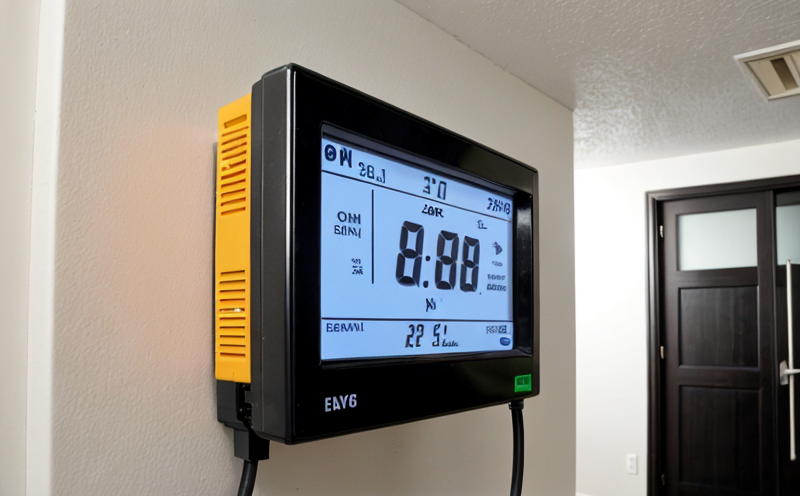IEC 62885 Energy Efficiency Testing of Vacuum Cleaners
The International Electrotechnical Commission (IEC) Standard IEC 62885 is designed to evaluate the energy efficiency of vacuum cleaners. This standard ensures that vacuum cleaner manufacturers adhere to strict environmental and performance criteria, which are critical for both consumer satisfaction and regulatory compliance.
The primary objective of this test is to assess the power consumption during various cleaning modes and conditions to determine how efficiently a vacuum cleaner operates under real-world usage scenarios. The standard covers a wide range of tests including no-load power consumption, load power consumption in different suction levels, energy efficiency classes, and noise level testing.
Manufacturers must ensure their products meet the specified energy efficiency criteria outlined by IEC 62885 to obtain certification that is recognized globally. This not only enhances consumer trust but also ensures compliance with international regulations aimed at reducing environmental impact.
The standard applies universally, making it a crucial tool for quality managers, compliance officers, R&D engineers, and procurement teams working within the energy sector or involved in the development of vacuum cleaning equipment. By adhering to IEC 62885, companies can demonstrate their commitment to sustainable practices while also optimizing product performance.
Compliance with this standard helps businesses stay ahead in an increasingly competitive market by ensuring that they meet or exceed global standards for energy efficiency. As consumer awareness of environmental issues grows, so too does the demand for products that are both effective and eco-friendly. Meeting these expectations ensures long-term success in the industry.
Additionally, compliance with IEC 62885 can lead to reduced operational costs due to lower electricity bills resulting from more efficient machinery. This is particularly important given current trends towards sustainability initiatives across all sectors of business operations.
Scope and Methodology
The IEC 62885 standard defines the procedures for testing the energy efficiency of vacuum cleaners, covering both residential and commercial models. The tests are conducted under controlled laboratory conditions to simulate typical use cases encountered by consumers.
- No-load power consumption: Measures how much electricity is used when the suction unit isn't engaged with any debris.
- Load power consumption: Evaluates energy usage during various cleaning levels, simulating actual cleaning tasks.
- Energy efficiency classes: Determines the overall class rating based on measured energy consumption figures.
The methodology involves setting up each vacuum cleaner according to manufacturer specifications and then performing consecutive tests that replicate everyday usage patterns. Results are compared against specified thresholds defined in the standard, ensuring consistency across different models.
For quality managers involved in product development or certification processes, understanding these methodologies is essential for meeting stringent regulatory requirements. Compliance officers will find this information particularly useful when auditing vendors or certifying new products.
Benefits
- Enhanced Consumer Satisfaction: Meeting IEC 62885 ensures that consumers receive high-quality, energy-efficient vacuum cleaners which perform reliably and cost-effectively over time.
- Global Recognition: Certification under this standard provides recognition internationally, enhancing brand reputation and market competitiveness.
- Economic Savings: By optimizing power consumption, manufacturers can reduce operational costs significantly. Consumers also benefit from lower electricity bills.
- Sustainability: Adherence to these standards contributes positively towards reducing overall carbon footprints associated with household appliances.
The implementation of IEC 62885 not only benefits the end-user but also supports broader goals around sustainability and environmental protection. It plays a vital role in fostering innovation within the industry, pushing manufacturers to continuously improve their products' energy efficiency while maintaining high levels of performance.
Why Choose This Test
- Regulatory Compliance: Ensures that your product meets international standards, avoiding potential penalties or recalls due to non-compliance.
- Market Differentiation: Demonstrates leadership in energy efficiency and sustainability, helping you stand out from competitors.
- Potential for Cost Reduction: By identifying areas where power consumption can be optimized early on in the design process, unnecessary expenses are avoided later down the line.
- Improved Product Quality: Rigorous testing helps identify potential issues early, leading to better-designed and more reliable products.
Selecting IEC 62885 for your vacuum cleaner’s energy efficiency assessment offers numerous advantages that can contribute significantly to business success. It provides a robust framework within which all aspects of the product are evaluated comprehensively, ensuring that every detail contributes towards achieving optimal performance and sustainability goals.





